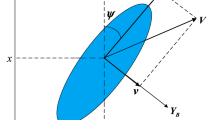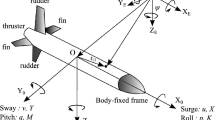Abstract
Underwater walking robot (UWR) is a kind of autonomous underwater vehicles which can walk underwater. In this work, the fixed-time tracking control problem of UWR with external disturbances, error constraints, and actuator faults is investigated. An interval type-2 fuzzy neural network approximator is designed to tackle nonlinear uncertainties, and a novel prescribed performance terminal sliding-mode surface is proposed to handle error constraints. Furthermore, two fault-tolerant controllers are given, where one is nonsingular and the other has higher steady-state precision. According to Lyapunov theory, the proposed controllers can guarantee that system states will converge to the expected values in a fixed time. Simulation results demonstrate the effectiveness of the proposed control strategies.












Similar content being viewed by others
References
Shukla, A., Karki, H.: Application of robotics in offshore oil and gas industry—a review Part II. Robot. Auton. Syst. 75, 508–524 (2016)
Howe, J.A., Husum, K., Inall, M.E., et al.: Autonomous underwater vehicle (AUV) observations of recent tidewater glacier retreat, western Svalbard. Mar. Geol. 417, 106009 (2019)
Palomer, A., Ridao, P., Ribas, D.: Inspection of an underwater structure using point-cloud SLAM with an AUV and a laser scanner. J. Field. Robot. 36(8), 1333–1344 (2019)
Picardi, G., Laschi, C., Calisti, M.: Model-based open loop control of a multigait legged underwater robot. Mechatronics 55, 162–170 (2018)
Yoo, S., Shim, H., Jun, B.H., et al.: Design of walking and swimming algorithms for a multi-legged underwater robot crabster CR200. Mar. Technol. Soc. J. 50(5), 74–87 (2016)
Li, Z., Yang, C., Ding, N., et al.: Robust adaptive motion control for underwater remotely operated vehicles with velocity constraints. Int. J. Control Autom. Syst. 10(2), 421–429 (2012)
Ghommam, J., Ferik, S.E., Saad, M.: Robust adaptive path-following control of underactuated marine vessel with off-track error constraint. Int. J. Syst. Sci. 49(7), 1540–1558 (2018)
Gao, Z., Guo, G.: Velocity free leader-follower formation control for autonomous underwater vehicles with line-of-sight range and angle constraints. Inf. Sci. 486, 359–378 (2019)
Qin, H., Li, C., Sun, Y., et al.: Adaptive trajectory tracking algorithm of unmanned surface vessel based on anti-windup compensator with full-state constraints. Ocean Eng. 200, 106906 (2020)
Yang, Y., Hua, C., Guan, X.: Finite time control design for bilateral teleoperation system with position synchronization error constrained. IEEE. T. Cybern. 46(3), 609–619 (2016)
Jin, X.: Adaptive fixed-time control for MIMO nonlinear systems with asymmetric output constraints using universal barrier functions. IEEE. Trans. Autom. Control. 64(7), 3046–3053 (2018)
Wang, Z., Liang, B., Sun, Y., et al.: Adaptive fault-tolerant prescribed-time control for teleoperation systems with position error constraints. IEEE Trans. Ind. Inform. 16(7), 4889–4899 (2020)
Zheng, Z., Ruan, L., Zhu, M.: Output-constrained tracking control of an underactuated autonomous underwater vehicle with uncertainties. Ocean. Eng. 175, 241–250 (2019)
Wang, N., Sun, J.C., Er, M.J.: Tracking-error-based universal adaptive fuzzy control for output tracking of nonlinear systems with completely unknown dynamics. IEEE. Trans. Fuzzy Syst. 26(2), 869–883 (2017)
Gundogdu, F.K., Kahraman, C.: A novel fuzzy TOPSIS method using emerging interval-valued spherical fuzzy sets. Eng. Appl. Artif. Intell. 85, 307–323 (2019)
Wu, Z., Karimi, H.R., Dang, C.: An approximation algorithm for graph partitioning via deterministic annealing neural network. Neural Netw. 117, 191–200 (2019)
Wu, Z., Karimi, H.R., Dang, C.: A deterministic annealing neural network algorithm for the minimum concave cost transportation problem. IEEE. Trans. Neural Netw. Learn. Syst. (2019). https://doi.org/10.1109/tnnls.2019.2955137
Zhang, Z., Wu, Y.: Adaptive fuzzy tracking control of autonomous underwater vehicles with output constraints. IEEE. Trans. Fuzzy Syst. (2020). https://doi.org/10.1109/TFUZZ.2020.2967294
Lin, T.C.: Observer-based robust adaptive interval type-2 fuzzy tracking control of multivariable nonlinear systems. Eng. Appl. Artif. Intell. 23(3), 386–399 (2010)
Moezi, S.A., Zakeri, E., Eghtesad, M.: Optimal adaptive interval type-2 fuzzy fractional-order backstepping sliding mode control method for some classes of nonlinear systems. ISA. Trans. 93, 23–39 (2019)
Golsefid, S.M., Zarandi, M.H., Turksen, I.B., et al.: Multi-central general type-2 fuzzy clustering approach for pattern recognitions. Inf. Sci. 328, 172–188 (2016)
Castillo, O., Melin, P., Ontiveros, E., et al.: A high-speed interval type 2 fuzzy system approach for dynamic parameter adaptation in metaheuristics. Eng. Appl. Artif. Intell. 85, 666–680 (2019)
Wu, D., Mendel, J.M.: Recommendations on designing practical interval type-2 fuzzy systems. Eng. Appl. Artif. Intell. 85, 182–193 (2019)
Kumbasar, T.: Robust Stability analysis and systematic design of single-input interval type-2 fuzzy logic controllers. IEEE Trans. Fuzzy Syst. 24(3), 675–694 (2016)
Yang, L., Liu, Z., Chen, Y., et al.: Energy efficient walking control for biped robots using interval type-2 fuzzy logic systems and optimized iteration algorithm. ISA Trans. 87, 143–153 (2019)
Dian, S., Hu, Y., Zhao, T., et al.: Adaptive backstepping control for flexible-joint manipulator using interval type-2 fuzzy neural network approximator. Nonlinear. Dyn. 97(2), 1567–1580 (2019)
Dong, H., Gao, L., Shen, P., et al.: An interval type-2 fuzzy logic controller design method for hydraulic actuators of a human-like robot by using improved drone squadron optimization. Int. J. Adv. Robot. Syst. 16(6), 1729881419891553 (2019)
Ruizgarcia, G., Hagras, H., Pomares, H., et al.: Toward a fuzzy logic system based on general forms of interval type-2 fuzzy sets. IEEE. Trans. Fuzzy. Syst. 27(12), 2381–2395 (2019)
Lu, X., Zhao, Y., Liu, M., et al.: Self-learning interval type-2 fuzzy neural network controllers for trajectory control of a Delta parallel robot. Neurocomputing. 283, 107–119 (2017)
Zhao, T., Yu, Q., Dian, S., et al.: Non-singleton general type-2 fuzzy control for a two-wheeled self-balancing robot. Int. J. Fuzzy Syst. 21(6), 1724–1737 (2019)
Taghavifar, H., Rakheja, S.: Path-tracking of autonomous vehicles using a novel adaptive robust exponential-like-sliding-mode fuzzy type-2 neural network controller. Mech. Syst. Signal Proc. 130, 41–55 (2019)
Liao, T., Chan, W.S., Yan, J.J., et al.: Distributed adaptive dynamic surface formation control for uncertain multiple quadrotor systems with interval type-2 fuzzy neural networks. Trans. Inst. Meas. Control. 41(7), 1861–1879 (2019)
Zhao, T., Chen, Y., Dian, S., et al.: General type-2 fuzzy gain scheduling PID controller with application to power-line inspection robots. Int. J. Fuzzy Syst. 22(1), 181–200 (2020)
Bechlioulis, C.P., Rovithakis, G.A.: Robust adaptive control of feedback linearizable MIMO nonlinear systems with prescribed performance. IEEE Trans. Autom. Control 53(9), 2090–2099 (2008)
Bechlioulis, C.P., Rovithakis, G.A.: Prescribed performance adaptive control for multi-input multi-output affine in the control nonlinear systems. IEEE. Trans. Autom. Control 55(5), 1220–1226 (2010)
Bechlioulis, C.P., Karras, G.C., Heshmati-Alamdari, S., et al.: Trajectory tracking with prescribed performance for underactuated underwater vehicles under model uncertainties and external disturbances. IEEE. Trans. Control Syst. Technol. 25(2), 429–440 (2016)
Elhaki, O., Shojaei, K.: Neural network-based target tracking control of underactuated autonomous underwater vehicles with a prescribed performance. Ocean. Eng. 167, 239–256 (2018)
Li, J., Du, J., Sun, Y., et al.: Robust adaptive trajectory tracking control of underactuated autonomous underwater vehicles with prescribed performance. Int. J. Robust. Nonlinear. Control 29(14), 4629–4643 (2019)
Shen, C., Shi, Y., Buckham, B.: Trajectory tracking control of an autonomous underwater vehicle using Lyapunov-based model predictive control. IEEE. Trans. Ind. Electron. 65(7), 5796–5805 (2017)
Mahapatra, S., Subudhi, B.: Design and experimental realization of a backstepping nonlinear H∞ control for an autonomous underwater vehicle using a nonlinear matrix inequality approach. Trans. Inst. Meas. Control. 40(11), 3390–3403 (2018)
Wang, J., Wang, C., Wei, Y., et al.: Command filter based adaptive neural trajectory tracking control of an underactuated underwater vehicle in three-dimensional space. Ocean. Eng. 180, 175–186 (2019)
Wu, Z., Jiang, B., Kao, Y.: Finite-time H∞ filtering for Itô stochastic Markovian jump systems with distributed time-varying delays based on optimisation algorithm. IET. Contr. Theory. Appl. 13(5), 702–710 (2019)
Xu, R., Tang, G., Han, L., et al.: Robust finite-time attitude tracking control of a CMG-based AUV with unknown disturbances and input saturation. IEEE. Access. 7, 56409–56422 (2019)
Patre, B.M., Londhe, P.S., Waghmare, L.M., et al.: Disturbance estimator based non-singular fast fuzzy terminal sliding mode control of an autonomous underwater vehicle. Ocean. Eng. 159, 372–387 (2018)
Polyakov, A.: Nonlinear feedback design for fixed-time stabilization of linear control systems. IEEE Trans. Autom. Control 57(8), 2106–2110 (2011)
Polyakov, A., Efimov, D., Perruquetti, W.: Finite-time and fixed-time stabilization: implicit Lyapunov function approach. Automatica. 51, 332–340 (2015)
Corradini, M.L., Cristofaro, A.: Nonsingular terminal sliding-mode control of nonlinear planar systems with global fixed-time stability guarantees. Automatica. 95, 561–565 (2018)
Gao, Z., Guo, G.: Fixed-time leader-follower formation control of autonomous underwater vehicles with event-triggered intermittent communications. IEEE Access. 6, 27902–27911 (2018)
Kadiyam, J., Parashar, A., Mohan, S., et al.: Actuator fault-tolerant control study of an underwater robot with four rotatable thrusters. Ocean Eng. 197, 106929 (2020)
Sun, Y., Ran, X., Li, Y., et al.: Thruster fault diagnosis method based on Gaussian particle filter for autonomous underwater vehicles. Int. J. Nav. Archit. Ocean Eng. 8(3), 243–251 (2016)
Zeghlache, S., Djerioui, A., Benyettou, L., et al.: Fault tolerant control for modified quadrotor via adaptive type-2 fuzzy backstepping subject to actuator faults. ISA Trans. 87, 330–345 (2019)
Liu, X., Zhang, M., Yao, F.: Adaptive fault tolerant control and thruster fault reconstruction for autonomous underwater vehicle. Ocean Eng. 155, 10–23 (2018)
Xu R, Tang G, Huang D, et al.: Adaptive fault-tolerant attitude control for a CMG-based underwater vehicle. J. Mar. Sci. Technol. 1–8 (2019)
Qin, H., Chen, H., Sun, Y., et al.: Distributed finite-time fault-tolerant containment control for multiple ocean Bottom Flying node systems with error constraints. Ocean. Eng. 189, 106341 (2019)
Jiang, B., Hu, Q., Friswell, M.I.: Fixed-time attitude control for rigid spacecraft with actuator saturation and faults. IEEE. Trans. Control. Syst. Technol. 24(5), 1892–1898 (2016)
Zuo, Z.: Nonsingular fixed-time consensus tracking for second-order multi-agent networks. Automatica. 54, 305–309 (2015)
Acknowledgements
This work was supported by National Natural Science Foundation of China under Grant (Nos. U1713205 and 61803119) and the Research Fund from Science and Technology on Underwater Vehicle Laboratory under Grant (No. 6142215180208).
Author information
Authors and Affiliations
Corresponding author
Rights and permissions
About this article
Cite this article
Qin, H., Yang, H., Sun, Y. et al. Adaptive Interval Type-2 Fuzzy Fixed-time Control for Underwater Walking Robot with Error Constraints and Actuator Faults Using Prescribed Performance Terminal Sliding-mode Surfaces. Int. J. Fuzzy Syst. 23, 1137–1149 (2021). https://doi.org/10.1007/s40815-020-00949-z
Received:
Revised:
Accepted:
Published:
Issue Date:
DOI: https://doi.org/10.1007/s40815-020-00949-z




